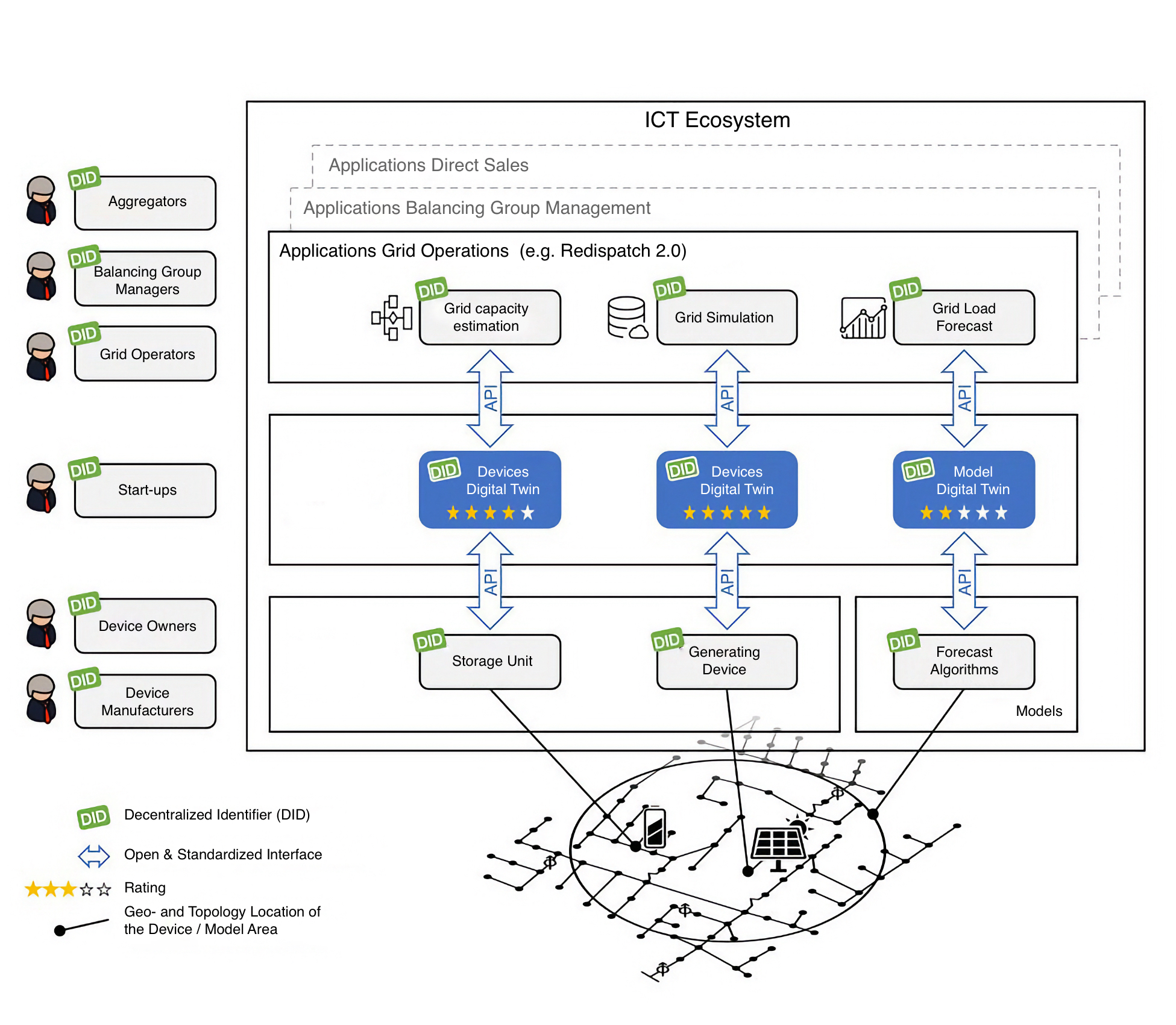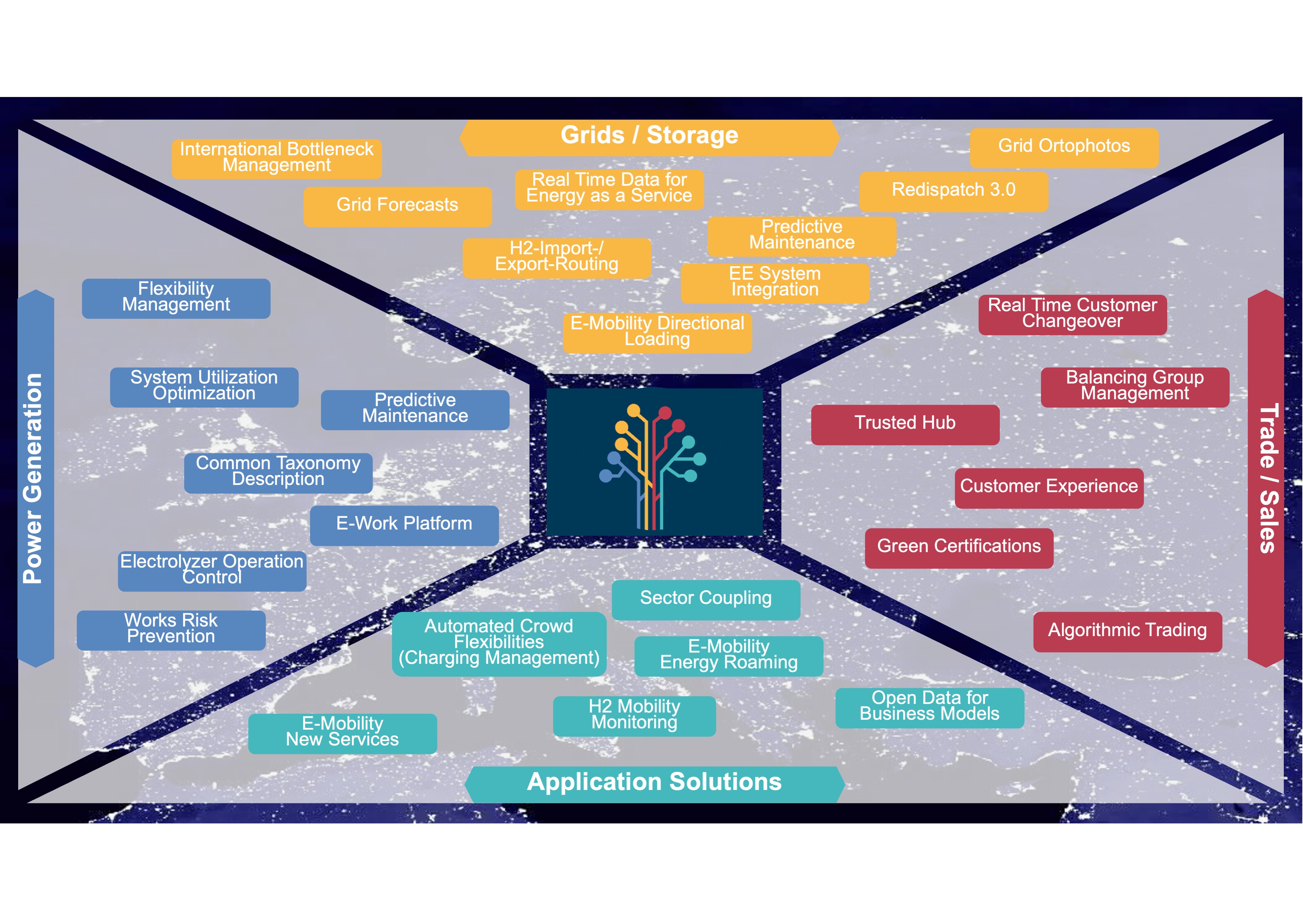
Originally published by Gaia-X Hub Germany: https://gaia-x-hub.de
Authors: Oliver Warweg, Prof. Dr. Michael Laskowski and Thomas Sprenger
Data ecosystems play a key role in the climate-neutral energy market of the future. Several research projects and a group of experts at the Gaia-X Hub Germany are working on making the growing complexity of the energy system manageable through digitalization and sovereign, cross-sector data exchange.
After market liberalization 25 years ago, the energy sector is facing a new transformation. As back then, success depends on the efficient exchange of data between market participants – with the difference that the dimension of data-based cooperation will reach a completely new level.
With the fall of the market monopolies for electricity and gas, the new freedom of choice for customers resulted in additional bureaucracy and an increased volume of data, for example when switching providers. The regulator reacted and created a standardized regime for electronic data exchange with the market communication (MaKo).
At that time, however, customers’ consumption patterns remained as predictable as the church calendar. Electricity was still generated centrally by around 700 large power plants, and millions of customers continued to do just one thing: consume. Today, electricity customers are also producers. Market communication now also has to process data from five and a half million small power plants that generate electricity from the sun, wind and biomass on a decentralized basis.
Digitalization in the energy system is lagging behind
Until climate neutrality is achieved, the granularity of the energy system will increase by further orders of magnitude if the energy industry has to manage data points down to the individual heat pump in order to keep generation and consumption in balance: Too much for an energy market in which information was still mainly exchanged via encrypted emails until spring 2024!
The regulator reacted again, now with the introduction of the new AS4 protocol and higher data security requirements for market communication. Together with the roll-out of a digital metering infrastructure, the sector will no longer be solely reliant on estimates for consumption forecasts and network planning in future, but will be able to operate with actual values on a quarter-hourly basis.
According to Sven Schillack, Digital Officer Energy Data Management at transmission system operator 50Hertz Transmission GmbH, even this data will not provide a sufficiently up-to-date picture of the increasingly complex grid situation: “The switch to AS4 is a quantum leap. But even the quarter-hour view will no longer be sufficient in the future. In the long term, we will need at least minute-by-minute data on current electricity consumption in the grid.”
On the road to the data age
Schillack and other experts are not only focusing on the growing requirements of a decentralized power supply, but also on the opportunities for a sustainable energy system. This is countered by the lack of data availability in the industry.
“The topic of data formats for market communication works and continues to develop,” explains Dr. Volker Flegel, Managing Director of CELRON GmbH. In this context, TenneT TSO GmbH is being supported by CELRON in the implementation of key topics for the development of the energy data-X data ecosystem. “But the digital transformation of the industry goes beyond the regulated area. There is a lack of standards here. A lack of data quality and availability is an unsolved problem,” says Flegel.
In addition to purely technical problems, the energy market expert points to unresolved regulatory issues: “The framework conditions for data-based services, digital marketplaces and energy apps have simply not been specified in a meaningful way. In our view, this speaks in favour of a common, standardized data ecosystem for the energy sector,” says Flegel.
Ecosystem for more flexibility and innovation in the energy market
This strategy is modeled on the efforts to establish a European data ecosystem under the name Gaia-X. At the Gaia-X Hub Germany, the initiative’s national contact point, utilities, grid operators, research institutions and service providers in the energy domain are developing the requirements for such a data infrastructure for their own sector. Their work incorporates the results of research projects that explore the possibilities of data spaces for the energy industry.
Digital twins for the distribution grid level
The idFlexNetz initiative, for example, is researching digital twins for the distribution grid level under the leadership of the E.ON subsidiary VSE AG from Saarbrücken with partners from industry, science and software consulting.
Figure: Example of a scheme for a digital marketplace in the idFlexNetz project for digital twins of devices and models. Image: VSE AG
Among other things, a digital twin for high-voltage transformers is being created in the project, which was launched in 2022. The model depicts operating data such as series, mode of operation, location and conditions of use as well as the condition of the device. “We want to model the real life cycle of grid-relevant hardware, not just its condition when it comes off the production line brand new,” says project manager Alexander Schalk, responsible for strategy, business field development, environment management and innovation at VSE AG. “The value of such data increases with the service life because we can take into account empirical values or seasonal fluctuations,” adds Dr. Ralf Derr, who also deals with corporate development and strategy at VSE AG.
The second digital twin of idFlexNetz goes beyond hardware modeling and maps complete generation scenarios for solar systems. Data such as weather conditions and the age-related capacity of the collectors are included in the calculation. Self-learning algorithms support the forecast.
“We want to find out how we can create such digital twins and make this data available to other suppliers, network operators or third parties via a marketplace,” explains Schalk.
Even though every industry is struggling with its own challenges when it comes to digitalization, those responsible at idFlexNetz see interoperability as a prerequisite for the success of data projects. “It makes no sense for every sector to reinvent the wheel. This is especially true for critical infrastructures, because everything new in our environment is rightly subject to extensive testing,” says Derr.
This is why the creators of idFlexNetz are aligning themselves with Gaia-X and are involved in the Gaia-X Hub. “The exchange with other projects and overarching initiatives such as Gaia-X as well as the involvement of industry partners is important for the acceptance and connectivity of our solutions. Ultimately, there will only be one standard for data ecosystems,” emphasizes Schalk.
Data services for balancing group loyalty and flexibility management
Another data room project, which was launched at the end of 2023, is pursuing a similar approach. Energy data X aims to develop the first data ecosystem for the energy sector based on Gaia-X. The aim of the consortium of 17 partner companies is to establish a secure and sovereign system for the use of energy data outside of regulated market communication.
Figure: Exemplary application areas of a data ecosystem in the European energy sector (use cases)
Specifically, the project aims to demonstrate the benefits of a data ecosystem using two applications. “The energy data-X consortium is building an energy data space in Gaia-X as the basis for sovereign data exchange in the energy sector. The energy data space will be evaluated on the basis of two exemplary use cases – balancing group management quality and the provision of flexibility based on automated processes,” explains project manager Steffen Hofer, an employee in the Strategy and Partnership department at consortium leader TenneT TSO GmbH.
A proof of concept is planned for both case studies. “Deviations in the balancing groups are currently billed to the originator responsible after two months,” says Hofer. “The information arrives weeks too late. The use of expensive balancing energy by the transmission system operator is correspondingly high,” says Hofer.
Energy data-X makes the real-time data available in the data ecosystem via smart meter gateways. “We show what is currently happening in the grid and in the balancing groups and can alert balancing group managers to deviations so that they can initiate countermeasures immediately,” explains Hofer.
The second use case aims to make the flexibility potential of generators, consumers and storage systems in the grid visible in real time. “In this way, grid operators can decide to the minute or second whether they should not switch off a plant after all because they can store the energy elsewhere. Or they can decide not to start up a gas turbine because a fleet of e-vehicle storage units can provide the required energy, for example,” explains Volker Flegel.
Gaia-X is intended to create the conditions for data protection-compliant, transparent and at the same time more efficient data infrastructures in the energy market. This would not only make it possible to adapt market communication to the increased complexity, but also to expand the circle of technical suppliers. This is because Gaia-X guarantees that data owners retain sovereignty over their data at all times.
It would even be possible to outsource MaKo services with legal certainty. Suppliers and grid operators could use trustworthy service providers to spread the costs of digital modernization across more shoulders. This would also give local suppliers and municipal utilities more economic leeway in a sustainable energy market.
New market for energy data services
However, a data ecosystem based on Gaia-X not only promises advantages in terms of costs and division of labor. Secure data exchange between market partners based on the BDEW role model, powerful programming interfaces and artificial intelligence create the conditions for a new market of data-based energy services.
In such an environment, start-ups could develop processes for checking the quality of billing-relevant data from intelligent, calibrated sensors for recording energy quantities. Specialized software companies would find a sales market for AI services that calculate more reliable forecasts for grid usage and balancing processes.
Electricity customers and local green electricity producers would also benefit from greater service convenience. Data services could, for example, monitor and display the current progress of a change of supplier. Electricity production and consumption in one’s own household could be coordinated using apps and optimized in terms of costs and CO2 balance.
More operational resilience
Ecosystems for data-based value creation in the sector could even make a contribution to security of energy supply in Germany: in order to adapt their systems flexibly to changing market conditions and absorb technical problems, suppliers and grid operators need a resilient IT and data infrastructure.
Their advantage: Gaia-X data rooms not only allow data to flow more efficiently. Reference architectures, technical standards and common rules create an ecosystem for infrastructure and data services that are interoperable and therefore interchangeable. This reduces dependency on individual technology providers and increases the overall operational resilience of the energy system.
Gaia-X can finally create an open market for IT services with more competition and freedom of choice for companies and customers, new business models and a high level of legal certainty for all participants at calculable costs.
Connectivity to other sectors
Despite its own rules and market laws, the digitalized energy sector is not a closed event. More and more data is becoming available in real time in the energy system, which is also valuable for other sectors. Vice versa, grid operators and utilities benefit from data from other industries such as the automotive industry, the construction sector or digitally networked communities. Thanks to openness and interoperability, Gaia-X data ecosystems can pay off across industries as a driver of data-based value creation and network the energy system more effectively with other sectors.
Conclusion
- Data ecosystems are pivotal for achieving a climate-neutral energy market, enabling efficient and secure data exchange among diverse market participants.
- The transition from centralized to decentralized power generation necessitates advanced digitalization, incorporating real-time data and enhanced data security protocols.
- Initiatives like Gaia-X and projects such as idFlexNetz and energy data X are crucial in developing standardized, interoperable data infrastructures that promote innovation, flexibility, and operational resilience in the energy sector.
- A robust data ecosystem not only supports better market communication but also fosters new data-based services, enhancing service convenience and sustainability for consumers and producers alike.
References
DESTATIS, Statistisches Bundesamt. (2023) „Zahl der Woche Nr. 25 vom 20. Juni 2023“. Available at: https://www.destatis.de/DE/Presse/Pressemitteilungen/Zahl-der-Woche/2023/PD23_25_p002.html#:~:text=Zahl%20der%20Woche%20Nr.&text=Wie%20das%20Statistische%20Bundesamt%20(Destatis,rund%2070%20600%20Megawatt%20installiert (Accessed: May 2024).
Forschungsgruppe Solarspeichersysteme. (2023) „Studie Stromspeicher-Inspektion 2023“. Available at: https://solar.htw-berlin.de/studien/stromspeicher-inspektion-2023/#:~:text=Die%20mittlere%20nutzbare%20Speicherkapazität%20der,von%204%2C3%20GWh%20aufweisen (Accessed: May 2024).
naturenergie netze. (2023) “Neue Herausforderungen zusammen meistern: Redispatch 2.0“. Available at: https://www.naturenergie-netze.de/einspeiser/information/redispatch-20#:~:text=Am%20sogenannten%20Redispatch%201.0%20waren,knapp%20700%20in%20Deutschland%20gab (Accessed: May 2024).
Schmidt, Alexander. Seeburger Blog. (2021) „15 Jahre Marktkommunikation Energiewirtschaft“. Available at: https://blog.seeburger.com/de/15-jahre-marktkommunikation-energiewirtschaft/ (Accessed: May 2024).
Seeburger AG. (2024) “MaKo – Informationen zur Marktkommunikation im deutschen Energiemarkt“. Available at: https://www.seeburger.com/de/ressourcen/wissenswertes/mako-informationen-zur-marktkommunikation-im-deutschen-energiemarkt#:~:text=Unter%20dem%20Begriff%20Marktkommunikation%2C%20kurz,Marktteilnehmern%20am%20deutschen%20Energiemarkt%20verstanden (Accessed: May 2024).
Statista. (2024) “Anzahl der Elektroautos in Deutschland von 2006 bis Januar 2024“. Available at: https://de.statista.com/statistik/daten/studie/265995/umfrage/anzahl-der-elektroautos-in-deutschland/ (Accessed: May 2024).
Walker, Amy. “Schlusslicht Deutschland: So viele Wärmepumpen werden in Europa installiert“, Frankfurter Rundschau, 14.09.2023. Availabe at: https://www.fr.de/wirtschaft/schlusslicht-deutschland-so-viele-waermepumpen-werden-in-europa-installiert-92515207.html#:~:text=Es%20werden%20aber%20auch%20die,etwas%20besser%20im%20Europavergleich%20aussieht.&text=Den%20größten%20Anteil%20an%20Wärmepumpen,Norwegen%2C%20Schweden%20und%20Dänemark%20installiert (Accessed: May 2024).
Warweg, Oliver; Laskowski, Michael Prof. Dr.; Fischer, Jan. Gaia-X Hub Deutschland. (2023) „Domäne Energie Positionspapier 2023“. Available at: https://gaia-x-hub.de/wp-content/uploads/2023/11/Domaene-Energie-Positionspapier-2023.pdf (Accessed: May 2024).


